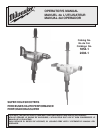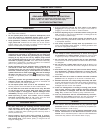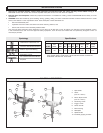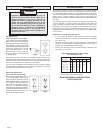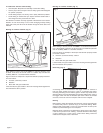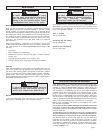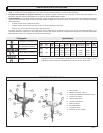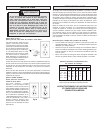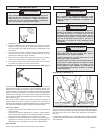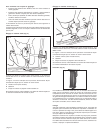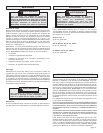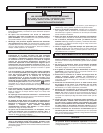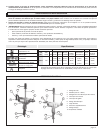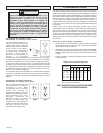
page 6
The direction of reaction is always opposite of the direction of bit rotation.
Reaction is even more likely to occur when enlarging already existing
holes and at the point when the bit breaks through the other side of the
material.
To reduce the chance of bit binding:
• Use sharp bits. Sharp bits are less likely to bind when drilling.
• Use the proper bit for the job. There are many types of bits designed
for specific purposes.
• Avoid drilling warped, wet, knotty, and or pitchy material if possible.
• Avoid drilling in material that you suspect contains hidden nails or
other things that may cause the bit to bind.
Reversing (Fig. 6)
A reversing switch is located below the trigger switch for removal of
bits from holes. Permit the motor to come to a complete stop before
reversing. Reversing the tool with the gears in motion may cause severe
damage. When removing selfeed bits from partially drilled holes, a flick of
the trigger switch will free the threaded pilot screw. When the threads
are loose, lift the bit from the workpiece with the motor stopped.
Drilling
Before drilling, clamp the material down securely. A poorly secured piece
of material may result in personal injury or inaccurate drilling. When
drilling in light gauge metal or wood, use a wooden block to back up the
material to prevent damage to the workpiece.
Mark the center of the hole to be drilled with a center punch to give the bit
a start and to prevent it from "walking." Lubricate the drill bit with cutting
oil when drilling iron or steel. Use a coolant when drilling nonferrous
metals such as copper, brass or aluminum.
Bracing for reverse rotation (Fig. 5)
When drilling in reverse, the bit will rotate in a counterclockwise direc-
tion. If the bit binds in the hole, the bit will come to a sudden stop and the
drill will suddenly react in a clockwise direction.
Figure 5 shows an example of the Super Hole-Shooter properly braced
for reverse rotation.
A. Reverse (counterclockwise) rotation
B. Reaction
C. Brace drill with pipe handle here
If the bit binds, the pipe handle or the motor housing braced against the
stud will hold the drill in position.
Bracing for forward rotation (Fig. 4)
When drilling in forward, the bit will rotate in a clockwise direction. If the
bit binds in the hole, the bit will come to a sudden stop and drill will
suddenly react in a counterclockwise direction.
Figure 4 shows an example of a Super Hole-Shooter properly braced for
forward rotation.
A. Forward (clockwise) rotation
B. Reaction
C. Brace drill with pipe handle here
If the bit binds, the pipe handle or the motor housing braced against the
stud will hold the drill in position.
A
B
C
B
C
A
Fig. 4
Fig. 5
Fig. 6



